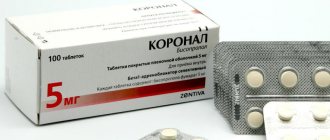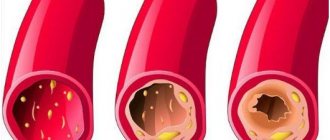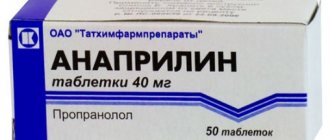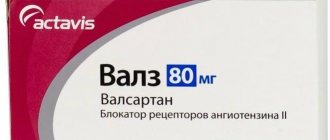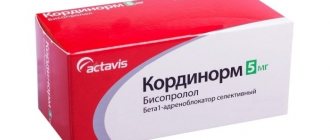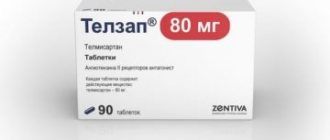- Composition and properties
- Advantages of the drug
- Release form and price
- Indications for use
- Directions for use and dosage
- Reception features
- Contraindications
- Use during pregnancy and lactation
- Side effects
- Drug interactions
- Analogs
The drug for arterial hypertension Amlodipine-Prana is quite in demand among patients suffering from high blood pressure, due to its excellent effectiveness and minimal side effects. We will talk further about the composition of the medication, properties, indications and contraindications for use, and features of use.
Composition and properties
A modern selective calcium fiber blocker - Amlodipine-Prana tablets. The drug has a pronounced antihypertensive effect due to the dilation of blood vessels and relaxation of the muscles of which they are composed.
The drug quite quickly reduces high levels of diastolic and systolic pressure without affecting the heart rate or causing tachycardia.
The tablets reduce the need of the heart muscle for large volumes of oxygen.
Main pharmacological properties of tablets:
- prevent vasoconstriction;
- dilate arteries in the myocardium, normalizing blood circulation processes in the heart muscle;
- reduces the severity and frequency of angina attacks;
- quickly, but not too sharply, lowers blood pressure, returning them to normal limits;
- stabilizes the condition of patients suffering from chronic heart failure (CHF).
The main active ingredient of the tablets is amlodipine, which is contained in the drug in varying quantities.
Overdose
In case of an overdose of Amlodipine-Prana, patients note the following symptoms:
A large dose of medication can reduce blood pressure to a critical level.
excessive decrease in blood pressure;- shock;
- collapse.
In cases of overdose, it is first of all important to rinse the patient’s stomach and prescribe the required dosage of activated carbon. It is important to monitor the state of the cardiovascular system and monitor blood pressure. The patient should be placed in a horizontal position and the lower limbs raised upward. With the active component amlodipine, extrarenal blood purification is unsuccessful.
Advantages of the drug
Doctors and patients choose Amlodipine-Pran due to the undeniable advantages of the drug, namely:
- long-term therapeutic effect – lasting more than 24 hours;
- do not affect blood glucose levels and cholesterol levels;
- can be used as part of complex therapy for hypertension, including simultaneously with some other medications for high blood pressure;
- significantly reduces the risk of developing severe complications of cardiovascular diseases - myocardial infarction, stroke, etc.;
- has many analogues of imported and domestic production.
Release form and price
The medicine goes on sale in the form of small round tablets, each of which contains 5 or 10 mg of the main active ingredient.
The manufacturer packages the medicine in blister packs of 10 pieces or in polymer jars of 40, 50, 60, 70, 80, 90 or 100 tablets each.
The tablets should be stored, according to the manufacturer's instructions, in a cool, dark place away from direct sunlight and children.
One of the undeniable advantages of the drug is its affordable price. You can buy the medicine in a pharmacy chain or online at a price of 40-45 rubles per pack of 10 pcs.
Indications for use
The main indication for the use of tablets is arterial hypertension with a persistent increase in blood pressure above 140/90.
The drug can also be used in the treatment of patients suffering from:
- stable angina pectoris;
- angina pectoris of unstable type.
In hypertensive patients, tablets are used both as monotherapy and as part of complex treatment.
Directions for use and dosage
According to the manufacturer's instructions, the drug should be taken strictly as prescribed by the doctor, if there are certain indications. The tablets are intended for oral use: taken orally once a day and washed down with a sufficient amount of drinking water.
The starting dosage in patients with elevated blood pressure, as well as in patients suffering from angina pectoris, is 5 mg once.
With low therapeutic efficacy or insufficient hypotensive effect, the daily dosage can be increased to 10 mg per day.
For patients with reduced body weight, as well as those suffering from severe kidney pathologies, severe renal failure, the drug is used in a lower dose, which is selected by a specialist individually, taking into account the severity of the pathology and general health.
Instructions for use
Doctors recommend taking the medicine in the morning after a light breakfast. The tablet is placed on the tongue and washed down with 120 ml of water.
The initial dose is 5 mg; depending on the severity of the underlying disease and the presence of concomitant pathologies, the dose can be adjusted. For chronic heart failure and as maintenance therapy, Amlodipine 2.5 mg is prescribed. During the first 2–3 weeks, dynamic blood pressure monitoring is required. If the effect is insignificant, the doctor increases the dosage to 10 mg.
Special instructions:
- Be careful when driving vehicles and operating other mechanisms that require concentration and quick reaction. May cause short-term dizziness.
- Careful monitoring of laboratory parameters in people with renal and hepatic insufficiency.
- It is undesirable to use Amlodipine during pregnancy - it is fetotoxic. However, doctors may prescribe it if the benefits of therapy outweigh the acceptable risk to the fetus.
- It is recommended to stop breastfeeding while using the drug. A woman can pump to maintain lactation.
- Use with caution in persons with aortic stenosis.
- Use in pediatric practice is prohibited due to lack of evidence base.
Reception features
The manufacturer's instructions inform about precautions and features of taking the drug that should be taken into account by patients taking Amlodipine-Prana tablets. The main ones:
- during drug therapy, it is necessary to strictly monitor body weight;
- During treatment, constant monitoring by a dentist is indicated to avoid the development of bleeding and sore gums;
- the drug may cause a withdrawal effect, so treatment with tablets should be stopped gradually to avoid worsening the condition and developing angina pectoris;
- the drug should not be used as part of complex therapy for patients during a hypertensive crisis;
- women who are being treated with the drug and are of reproductive age should use reliable contraception;
- tablets should not be combined with alcoholic beverages;
- the drug can affect the speed of psychomotor reactions and concentration, therefore it should be used with extreme caution when driving vehicles or while engaging in potentially hazardous activities;
- tablets should be taken with extreme caution in patients with severe pathologies of the liver and kidneys;
- in elderly patients, a reduction in the daily dose of the drug is not required.
Instructions for use of "Amlodipine-Pran"
When calculating the dose of the drug, weight must be taken into account.
The medication is taken orally once a day. Take the tablets with plenty of water. In patients with arterial hypertension and angina pectoris, therapy begins with 5 milligrams per day. If necessary, the dosage can be increased to 10 milligrams. If the patient has a small body weight and short stature, or he has been diagnosed with liver disorders, then he is sometimes prescribed a lower dosage.
Contraindications
The reasons for refusing therapy with Amlodipine-Pran tablets are the following pathologies and conditions:
- severe arterial hypotension;
- increased individual sensitivity to individual components of the drug, as well as intolerance to the substances included in the composition;
- acute myocardial infarction;
- state of shock;
- the age of the patient is under 18 years of age due to the lack of clinical trial data regarding the use of the drug in this category of patients.
Use during pregnancy and lactation
The instructions for the drug indicate a prohibition on the use of tablets in pregnant women due to the possible effect on the formation and development of the fetus. In some cases, taking a medication is acceptable when the potential benefits to the mother far outweigh the risks to the unborn child.
The substances contained in the tablets tend to pass into breast milk. That is why during lactation, taking pills should be stopped or lactation should be abandoned for a while.
Amlodipine-Prana
The frequency of adverse reactions listed below was determined according to the following (WHO classification): very often - more than 1/10; often - from more than 1/100 to less than 1/10; uncommon - from more than 1/1000 to less than 1/100; rarely - from more than 1/10000 to less than 1/1000; very rarely - from less than 1/10000, including individual messages; unknown—it is not possible to estimate the frequency from the available data.
From the SSS side:
often - palpitations, peripheral edema (ankles and feet), flushes of blood to the skin of the face; infrequently - excessive decrease in blood pressure; very rarely - fainting, vasculitis, orthostatic hypotension, development or worsening of CHF, cardiac arrhythmias (including bradycardia, ventricular tachycardia and atrial fibrillation), myocardial infarction, chest pain.
From the musculoskeletal system:
uncommon - arthralgia, muscle cramps, myalgia, back pain, arthrosis; rarely - myasthenia.
From the nervous system:
often - headache, dizziness, increased fatigue, drowsiness; uncommon - asthenia, general malaise, hypoesthesia, paresthesia, peripheral neuropathy, tremor, insomnia, mood lability, unusual dreams, increased excitability, depression, anxiety, ringing in the ears, perversion of taste; very rarely - migraine, increased sweating, apathy, agitation, ataxia, amnesia; unknown - extrapyramidal disorders.
From the digestive system:
often - nausea, abdominal pain; uncommon - vomiting, constipation or diarrhea, flatulence, dyspepsia, anorexia, dry mouth, thirst; rarely - gum hyperplasia, increased appetite; very rarely - pancreatitis, gastritis, jaundice (due to cholestasis), hyperbilirubinemia, increased activity of liver transaminases, hepatitis.
From the hematopoietic organs:
very rarely - thrombocytopenic purpura, leukopenia, thrombocytopenia.
From the respiratory system:
infrequently - shortness of breath, rhinitis, nosebleeds; very rarely - cough.
From the senses:
uncommon - diplopia, impaired accommodation, xerophthalmia, conjunctivitis, eye pain, visual impairment.
From the genitourinary system:
infrequently - frequent urination, painful urination, nocturia, erectile dysfunction; very rarely - dysuria, polyuria.
From the skin:
rarely - dermatitis; very rarely - alopecia, xeroderma, cold sweat, skin pigmentation disorder.
Metabolic disorders:
very rarely - hyperglycemia; infrequently - increase/decrease in body weight.
Allergic reactions:
infrequently - skin itching, rash (including erythematous, maculopapular, urticaria); very rarely - angioedema, erythema multiforme.
Laboratory indicators:
very rarely - hyperglycemia.
Other:
infrequently - chills, gynecomastia, pain of unspecified localization; very rarely - parosmia.
Side effects
Amlodipine-Pran tablets are well tolerated by patients of all ages. Despite this, in some cases, adverse reactions to the drug may occur. The latter are most often associated with the individual characteristics of the patient’s body and quickly disappear without specific therapy with other drugs.
The most common ones are:
- the appearance of swelling in the legs;
- cardiopalmus;
- persistent decrease in blood pressure - arterial hypotension;
- heart failure;
- development of vasculitis;
- severe headaches;
- dizziness;
- chest pain;
- weakness, drowsiness, apathy;
- fast fatiguability;
- fainting;
- increased anxiety.
Quite often, tablets become the “culprit” for disorders of the gastrointestinal tract:
- diarrhea;
- constipation;
- pain in the stomach;
- quite strong vomiting.
It is extremely rare that taking pills provokes adverse reactions from the respiratory system:
- pharyngitis;
- cough;
- nasal congestion.
As well as allergic reactions in the form of skin rashes and swelling.
Possible side effects
Like any medicine, this medicine may cause side effects. With long-term use of the medicine, the following are possible:
- hyperemia of the facial skin (increased blood flow in the vessels);
- heart rate increases, rhythm disturbance;
- weakness, fatigue with minor physical and psychological stress;
- headaches (there are cases of migraine);
- dizziness, visual impairment;
- drowsiness;
- asthenic syndrome;
frequent mood swings;- swelling of the lower extremities;
- Gospel disease (jaundice);
- Frequent urination, problems with potency are rare;
- problems with the normal functioning of the gastrointestinal tract, accompanied by nausea, abdominal pain, and changes in bowel movements;
- shortness of breath appears with minor exertion;
- very rarely paresthesia and pain in the extremities are recorded;
- a rash and erythema may appear on the body and facial skin;
- inflammation of the gums
Drug interactions
When starting treatment with the drug, you should consider the possibility of its interaction with other drugs. The manufacturer warns in the instructions about the following possible drug interactions:
- simultaneous use of tablets with other antihypertensive drugs can cause a more significant decrease in blood pressure, as well as provoke arterial hypotension;
- estrogens and symptomimetics reduce the hypotensive properties of the drug by retaining sodium in the body;
- parallel use with drugs for inhalation anesthesia can lead to a sharp decrease in blood pressure;
- taking the drug Orlistat can cause a sharp jump in blood pressure up to the development of a hypertensive crisis;
- Non-steroidal anti-inflammatory drugs reduce the hypotensive effect of Amlodipine. Simultaneous use causes fluid retention in the body, as well as deterioration of kidney function;
- use with quinidine enhances the antihypertensive effect of Amlodipine-Pran.
Interaction with other medications
Taking the described medication in combination with other calcium channel blockers may increase the hypotensive effect. The use of estrogens, on the contrary, provokes a decrease in the antihypertensive effect due to the retention of sodium ions in the patient’s body. An increase in the hypotensive effect is also observed with the use of inhalation anesthesia, as well as with the use of the drug Amiodarone. The drug "Orlisat" when used together with the described drug causes an excessive increase in blood pressure, as a result of which a hypertensive crisis sometimes develops. Since non-steroidal anti-inflammatory drugs retain water in the body, they can reduce the effect of Amlodipine-Pran, aimed at lowering blood pressure.
Analogs
In case of individual poor tolerability of the drug, the appearance of side effects or low therapeutic efficacy, it may be necessary to replace the drug with an analogue. The most popular analogue drugs of Amlodipine-Pran presented on the domestic pharmaceutical market:
- Adipin;
- Amlodil;
- Amlorus;
- Norwax;
- Cardilopin.
Due to its excellent antihypertensive effect, as well as good tolerability, Amlodipine-Pran tablets are often prescribed by doctors. Before starting to use the medicine, you should study the instructions for use and strictly follow the dosage recommended by the specialist.


